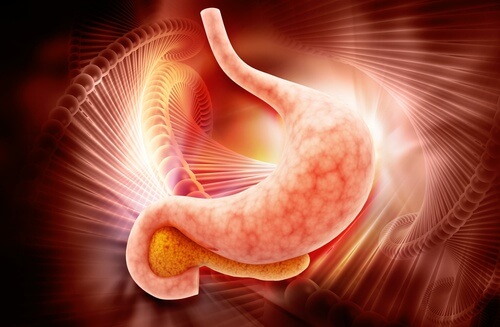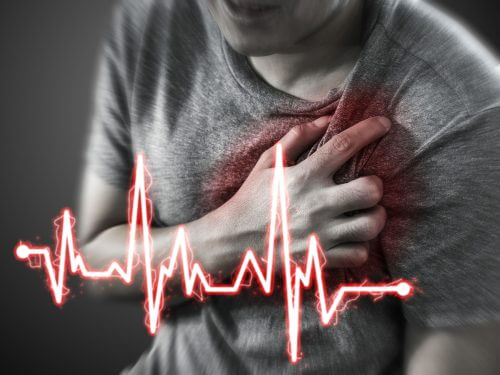Epigastralgia: That Annoying Pain in the Pit of Your Stomach


Written and verified by the doctor José Gerardo Rosciano Paganelli
Epigastralgia is not just common stomach pain. After all, this condition affects multiple areas of the abdomen.
Patients who experience this type of digestive pathology have pain in the epigastrium, located in the upper region of the abdomen, as shown by this study by the Guadalajara University Hospital in Mexico.
The person will often feel as if a rope is squeezing their entire abdomen, with an oppressive burning sensation that results in nausea and a lot of discomfort.
The pain is so intense that it’s common for people to be afraid and go to the emergency room because they don’t know what’s happening.
Although, in the majority of cases, the cause of this pain is simply indigestion, epigastralgia can be associated with series of other disorders or diseases that require a proper diagnosis.
As we continue, we’ll learn more about this topic.
What is epigastralgia?

As we already know, there are many organs and structures in this area, which makes it difficult to know what is causing this pain right away.
Also, the patient can suffer continuous pain day to day or the pain can show up suddenly.
The symptoms are as follows:
- Intense pain in the epigastrium
- Nausea, as stated in this investigation carried out by the Las Condes Clinic in Chile.
- Burning in the stomach
- Cramps in the abdomen
- Cold sweats
- Gas, according to this study by the Virgin Health Hospital in Toledo.
- Episodes of diarrhea or constipation
What causes epigastralgia?

Epigastralgia caused by problems in the esophagus
- Esophagitis, as stated in this investigation carried out by the Navarra hospital, and a hiatal hernia.
- Esophagitis comes from esophageal reflux, something that should be treated as soon as possible.
- A hiatal hernia is common after the age of 50, according to this study by the Doctor Peset Hospital in Valencia. It causes heart burn and problems with swallowing, digestion, bad breath, etc.
Problems in the stomach
- Epigastralgia can originate exclusively in the stomach.
- One of the possible causes is an ulcer, especially a peptic ulcer. The pain becomes more intense at night and we usually feel relief when we’re eating.
- On the other hand, as we’ve pointed out, in a large number of cases epigastralgia is due to acute gastritis, as shown in this investigation by the Archbishop Loayza National hospital in Peru. This can be infectious, toxic or alimentary.
- In this case, the pain is very intense and is usually accompanied by vomiting and extreme discomfort.
Epigastralgia caused by intestinal problems
This fact is important. On occasion, this pain in the upper abdomen originates from appendicitis.
- Because of this, if you feel strong pain the upper stomach, it is important that you do not hesitate to consult a doctor, or go to the emergency room if the suffering is intense.
- Also, Crohn’s disease, in its early stages, is usually accompanied by pain in the epigastric area.
- If epigastralgia reaches the left side of the abdomen, you could be dealing with a problem in the colon, such as the diverticula (according to this study by the Ramón y Cajal University Hospital).
- An irritated colon is also one of the causes of epigastralgia, according to information in the previously mentioned study by the Ramón y Cajal Hospital. In this case, it’s common to experience pain in the form of colic and gas.
Problems in the pancreas
Acute pancreatitis usually starts with epigastric pain, as stated in information published by the Mayo Clinic. It’s important to be aware of these types of symptoms located in the upper stomach, especially if it is accompanied by vomiting, or abdominal distention.
Careful, it can be warning of a cardiac problem

- An acute myocardial infarction (heart attack) can produce epigastralgia, meaning you’ll experience pain in the upper abdomen, according to this information by the Campus Medynet, an official online medical platform for health information and advice.
- The pain may be sudden, oppressive and accompanied by vomiting. In any case, it’s important to rule it out, and it never hurts to go to the emergency room to get a diagnosis as soon as you notice any discomfort.
What can I do to prevent problems associated with epigastralgia?
As you’ve seen, epigastralgia is is a symptom associated with several different medical conditions.
Regardless of all of the different options (indigestion, ulcers, irritated colon, cardiac problems…), they all have one element in common that can help us to reduce the probability of suffering from these types of illnesses.
That common factor is diet. If you watch your diets, you can reduce the probability of suffering or worsening these illnesses, as proven by this study carried out by the Provincial Center of Hygiene and Epidemiology in Cuba.
So, take note of the following advice:
- Reduce your consumption of fats.
- Choose alkaline foods.
- Eat smaller meals more often throughout the day.
- Eat fresh fruits and vegetables, and avoid foods with preservatives or other chemicals.
- Reduce sugar and salt consumption.
- Be careful with drugs such as ibuprofen and other non-steroidal anti inflammatories.

In conclusion, don’t hesitate to consult a doctor with any problems, pains or changes in your digestive system.
Prevention and taking care of yourself are synonymous with health and well-being.
All cited sources were thoroughly reviewed by our team to ensure their quality, reliability, currency, and validity. The bibliography of this article was considered reliable and of academic or scientific accuracy.
- Latarjet, Michel (2013). «Músculos, fascias y aponeurosis del abdomen». Anatomía humana. Buenos Aires: Médica Panamericana. p. 1328. ISBN 978-950-06-1369-9.
- Rodríguez-Lago, I., & Cabriada, J. L. (2016). Protocolo diagnóstico de la epigastralgia aguda. Medicine (Spain). https://doi.org/10.1016/j.med.2016.01.014
- Boscá, A. (2014). Epigastralgia. Medicina Interna.
This text is provided for informational purposes only and does not replace consultation with a professional. If in doubt, consult your specialist.








